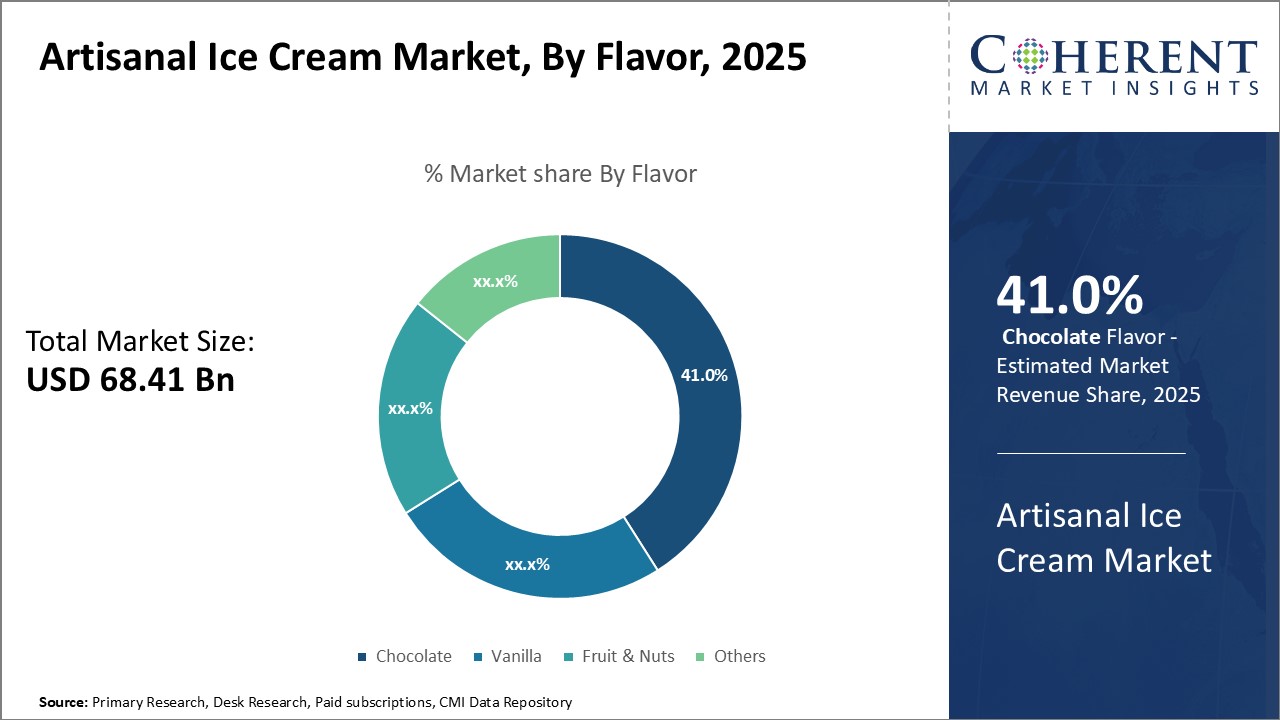The artisanal ice cream Market size is valued at US$ 68.34 Bn in 2024 and is expected to reach US$ 93.62 Bn by 2031, growing at a compound annual growth rate (CAGR) of 4.6% from 2024 to 2031.
Artisanal ice cream is largely made of organic ingredients and does not include chemicals. Rising health consciousness among the population is driving growth of this market. Companies around the world are focusing on offering low sugar or sugar-free artisanal ice cream for diabetic patients. Furthermore, companies are also providing healthy flavors in the artisanal ice cream, which include a variety of vegetables. These factors are expected to increase the demand for artisanal ice creams over the forecast period. Distribution channels for artisanal ice cream includes hypermarkets & supermarkets, specialty stores, online channel, and others. Other distribution channels comprise convenience stores and departmental stores. The online channel is predicted to grow at a faster pace during the forecast period, attributing to increased penetration of internet and mobile phones across the globe.
High prices associated with artisanal ice cream are projected to hamper market growth. The high prices of artisanal ice cream are a result of three factors: ingredients, production processes, and distribution. However, players operating in the artisanal ice cream industry are focused on developing production technology that can offer better product quality with a higher shelf life. For instance, DuPont offers the CREMODAN 500 COLDLINE emulsifier & stabilizer system, which is specially designed to boost quality of traditional, handmade ice cream without homogenization or pasteurization. It provides flavor as well as storage stability without heat treatment. The emulsifier and stabilizer system provides highly stable ice cream with high freshness and flavor.
Market Regional Insights:
Figure 1. Global Artisanal Ice Cream Market Share (%), By Region, 2024

To learn more about this report, request a free sample copy
Analyst’s Views:
The global artisanal ice cream market is expected to grow steadily over the forecast period. The market is driven by rising health consciousness among consumers and a growing preference for premium and authentic products. However, stringent regulations regarding food production and the high production costs associated with artisanal ice cream pose challenges to market players. Moreover, commodity price fluctuations influence profit margins.
North America dominates the market currently due to the strong presence of artisanal ice cream brands and high per capita ice cream consumption in the region. The Asia Pacific region offers lucrative opportunities for market expansion, led by growing health awareness in countries like India and China. Artisanal ice cream brands can capitalize on the opportunities by innovative flavors, clean labeling, and premiumization. Strategic marketing initiatives like collaborations with food service outlets and celebrity endorsements help boost brand visibility. Focus on organic and natural claims, along with premium quality ingredients, aid demand from health conscious consumers. Expanding distribution channels through exclusive retail stores and online platforms also support market growth.
In summary, while stringent regulations and high costs challenge artisanal ice cream producers, demand drivers like health trends, product innovations, and regional expansion present opportunities over the forecast period.
Market Drivers:
Market Opportunities:
Product innovation and new product launches: Product innovation and new product launches present a major opportunity for growth in this market. Consumers are increasingly seeking new flavors, unique ingredients, and novel formats that provide exciting taste experiences compared to standard store-bought ice cream products. Artisanal ice cream makers who can successfully deliver innovative products have a strong advantage to capture more market share. Some areas ripe for new product development include using premium or exotic ingredients not commonly found in ice cream, such as fresh herbs, flowers, nuts, and fruits sourced from local farms. Developing ice cream sandwiches, cones, and dessert products offers possibilities for expansion beyond traditional pint and quart containers. Exploring nontraditional formats like popsicles, frozen yogurt, or sorbets made with natural sweeteners provides healthier options to attract more health-conscious consumers. According to Food and Agriculture Organization 2022 data from the United Nations Food and Agriculture Organization, worldwide per capita consumption of fruit is steadily rising with increasing demand for high-quality, fresh, and locally-sourced produce. As a result, artisanal ice cream companies introducing limited edition seasonal flavors showcasing fruits and ingredients currently in season have an opportunity gain interest and attract trial among consumers interested in locally produced food. Successful new product innovation helps drive increased frequency of purchases and customer loyalty to artisanal brands.
Geographic expansion into untapped markets: Geographic expansion into new and untapped markets provides huge potential for growth in this market. As consumer preferences are shifting towards premium and handcrafted products, many developing nations are witnessing rising disposable incomes and growing middle class populations. These socio-economic changes are increasing the demand for high-quality ice cream experiences. While the market remains heavily concentrated in developed regions currently, opening new retail locations in emerging economies could allow brands to tap into these fast-developing consumer bases.
Many Latin American, Asia Pacific and African countries represent sizable untapped opportunities. For example, according to data from the United Nations, Brazil saw a 13% decline in poverty levels from 2020 to 2021, widening the consumer pool with more discretionary spending abilities. Similarly, Indonesia saw increases of over 0.065 Bn people entering the middle-income group from 2011-2019, as stated by the World Bank, enhancing demand for aspirational imported brands. Environmental changes are also benefiting the industry; according to the International Panel on Climate Change, warmer temperatures and climates are expanding across many developing regions, making them more conducive to ice cream consumption throughout the year rather than just summer seasons. By establishing local manufacturing and supply chain operations, artisanal companies can address new customers in these rapidly growing emerging markets. Catering ice cream varieties, flavors, and packaging tailored to local preferences will be critical for success. Moreover, strategic retail partnerships with supermarkets and cafes can help navigate regulatory frameworks and introduce niche brands on a mass scale. While initial investments may be substantial, first-mover advantages into untapped geographies with favorable socio-economic trends could unlock exponential gains for market leaders over the long run in the global artisanal ice cream industry.
Artisanal Ice Cream Market Report Coverage
| Report Coverage | Details | ||
|---|---|---|---|
| Base Year: | 2023 | Market Size in 2024: | US$ 68.34 Bn |
| Historical Data for: | 2019 to 2023 | Forecast Period: | 2024 - 2031 |
| Forecast Period 2024 to 2031 CAGR: | 4.6% | 2031 Value Projection: | US$ 93.62 Bn |
| Geographies covered: |
|
||
| Segments covered: |
|
||
| Companies covered: |
Unilever, Nestle, Van Leeuwen, Nestlé S.A, Fiasco Gelato Cafes Ltd., Bi-Rite Creamery, Carmela Ice Cream Co.,True & 12 Handmade Ice Cream, Boho Gelato, Gracie's Ice Cream, High Road Craft Brands |
||
| Growth Drivers: |
|
||
| Restraints & Challenges: |
|
||
Market Trends:
Rising health consciousness and preference for ingredients with low sugar content: Consumers around the world are becoming increasingly health conscious and choosing products with cleaner labels. They are seeking out options with fewer ingredients and less sugar. This preference for natural and nutritious ingredients is having a major impact on the artisanal ice cream industry. Artisanal producers are responding by developing new lines that cater to this demand while still emphasizing premium and local ingredients.
Many ice cream shops are introducing low-sugar or sugar-free varieties made with natural sweeteners like maple syrup, honey, or fruit purees instead of conventional sugar. For example, a survey done by the International Dairy Foods Association in 2021 of over 5000 US households found nearly 70% said they preferred ice cream brands that use minimal natural sweeteners rather than plain sugar. This shows customers are willing to experiment with new flavor profiles that fit their health goals. Larger chains are also capturing this market by acquiring or partnering with boutique brands known for high-quality, fresh ingredients. The low-sugar trend is giving a boost to lesser-known fruits commonly featured in artisanal ice creams. According to the United Nations Food and Agriculture Organization's 2020 data, sales of berries, stone fruits, and tropical varieties grew significantly in developed nations as consumers sought new ways to enjoy creamy desserts with less sugar impact. Flavors spotlighting seasonal, nutritious local fruits allow artisanal shops to charge a premium for unique options aligned with consumer values of health, freshness, and supporting small producers.
Increase in artisanal ice cream cafes and parlors: The growing trend of artisanal ice cream cafes and parlors is having a significant influence on this market. The rise of these specialty ice cream shops has ushered in an era where the focus is as much on the atmosphere and customer experience in the shop as it is on the ice cream itself. Many parlors have become community gathering spots that attract both locals and those traveling. They often feature eclectic menu items beyond just ice cream such as baked goods, coffee, booze-infused soft serves, etc., to encourage more spending per visitor. The success of this business model has even inspired national franchises to launch their own boutique style parlors with an artisanal aesthetic. The growing popularity of artisanal ice cream cafes among both consumers and businesses is directly fueling growth in the global market. Specialty shops require unique, small-batch recipes versus mass-produced generics. According to Dairy Foods magazine's 2020 Sweets & Snacks Expo survey, 53% of ice cream manufacturers have introduced artisanal or specialty flavors in the past year to meet this consumer demand. Small dairy farms in Europe and North America are also experiencing increased interest in procuring milk specifically for artisanal ice creams. For example, Ireland’s The Aran Group, which produces milk for companies like Eli's Cheesecake, witnessed a 42% spike in orders in 2021 for niche ice cream makers compared to 2020. In conclusion, the expansion of artisanal ice cream cafes worldwide has significantly boosted the global market by creating demand for higher quality, small-batch products over generic items. It has also shifted consumer preferences towards experiencing ice cream in an atmospheric setting rather than just purchasing pints to consume at home.
Market Restraints:
Recent Developments:
New Product launches:
Mergers and Acquisition:
Figure 2. Global Artisanal Ice Cream Market Share (%), By Flavor, 2024

To learn more about this report, request a free sample copy
Top Companies in this Market
Definition: An artisanal ice cream is a handmade ice cream made by an artisan or skilled craftsperson. The ingredients used in artisanal ice cream include milk, butter, cocoa, dried fruit, eggs, and cream, which are blended together and whisked to make a light, melt-in-the-mouth texture.
Frequently Asked Questions
Joining thousands of companies around the world committed to making the Excellent Business Solutions.
View All Our Clients